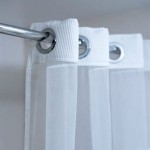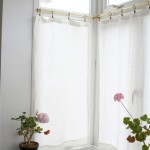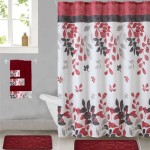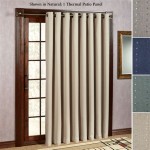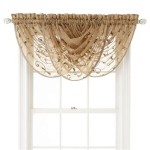Curtain Liners for Grommet Curtains: Enhancing Functionality and Aesthetics
Grommet curtains, characterized by their metal rings or grommets that allow them to hang from a curtain rod, offer a modern and streamlined aesthetic to window treatments. While grommet curtains themselves provide varying levels of light control and privacy depending on the fabric used, incorporating curtain liners significantly enhances their functionality and provides a multitude of benefits. Selecting the appropriate liner and understanding its purpose is crucial for maximizing the potential of grommet curtains.
Curtain liners are separate fabric panels designed to hang behind the main curtain panel. They attach to the curtain in a variety of ways, the most common being hooks, rings, or a rod pocket. When used with grommet curtains, the liner attaches to the curtain itself, either using the same grommets (if designed for that purpose) or through alternative attachment methods compatible with grommet construction. The choice of liner depends on the desired outcome, such as improved light blocking, enhanced insulation, or added privacy.
Light Control and Blackout Capabilities
One of the primary reasons for using curtain liners with grommet curtains is to enhance light control. While some grommet curtains are made from thicker fabrics that offer decent light filtering, they often fall short of providing complete darkness, particularly those made from lighter or sheer materials. A blackout liner, constructed from tightly woven, opaque fabric, effectively blocks nearly all incoming light. This is especially beneficial in bedrooms, nurseries, or home theaters where minimizing light intrusion is essential. The blackout liner creates a dark and conducive environment for sleep, relaxation, or focused viewing.
Conversely, a light-filtering liner allows some light to pass through while still providing a degree of privacy. This type of liner softens the incoming sunlight, reducing glare and creating a more ambient atmosphere in the room. Light filtering liners are well-suited for living rooms, dining rooms, or offices where a balance between natural light and privacy is desired. The density and weave of the light-filtering liner will determine the level of light that is allowed to penetrate.
The effectiveness of the liner is also dependent on the color. Darker colors generally block more light than lighter colors, even within the same fabric type. Therefore, when maximum light control is the objective, opting for a dark-colored blackout liner is the most effective strategy. White or light-colored blackout liners may still allow some light to pass through, particularly around the edges.
Insulation and Energy Efficiency
Curtain liners contribute significantly to insulation and energy efficiency. Windows are often a source of heat loss during the winter and heat gain during the summer. Adding a thermal liner to grommet curtains creates an extra layer of insulation, reducing the transfer of heat between the interior of the room and the exterior environment. This translates to lower energy bills and a more comfortable indoor climate.
Thermal liners are typically constructed from multiple layers of fabric, often including a layer of acrylic foam or a metallic coating. These materials are designed to reflect heat back into the room during the winter and reflect heat away from the room during the summer. The effectiveness of a thermal liner is determined by its R-value, which measures its resistance to heat flow. Higher R-values indicate better insulation performance.
In addition to reducing energy consumption, thermal liners also help to reduce condensation on windows during cold weather. By maintaining a more consistent temperature on the window surface, thermal liners minimize the formation of moisture, which can lead to mold and mildew growth. This is particularly important in humid climates or in rooms with poor ventilation.
Privacy Enhancement and Fabric Protection
Privacy is another major consideration when choosing curtain liners for grommet curtains. Liners provide an additional layer of protection against prying eyes, particularly during nighttime hours when interior lights are on. Even if the main curtain fabric is relatively opaque, a liner ensures complete privacy, especially in rooms that are located close to neighboring buildings or busy streets.
The density and color of the liner will affect its privacy level. Darker, thicker liners offer the highest degree of privacy, while lighter, thinner liners may allow some silhouettes or shadows to be visible from the outside. Selecting a liner that complements the color of the main curtain fabric can also enhance its privacy. A liner that is significantly lighter than the main curtain may create a contrasting effect that makes the curtain appear more transparent.
Beyond privacy, curtain liners also protect the main curtain fabric from fading and damage caused by sunlight. Ultraviolet (UV) rays can degrade the fibers of fabrics over time, leading to discoloration and weakening. A liner acts as a barrier, shielding the main curtain from direct sunlight and extending its lifespan. This is particularly important for delicate or expensive fabrics that are more susceptible to UV damage.
Furthermore, liners protect curtains from dust, dirt, and other airborne pollutants. These contaminants can accumulate on the curtain fabric over time, making it look dull and dingy. A liner absorbs these pollutants, keeping the main curtain cleaner and fresher for longer. Regular cleaning or replacement of the liner can help to maintain the appearance and hygiene of the entire window treatment.
Types of Curtain Liner Fabrics
The material of the curtain liner is a critical factor in determining its performance characteristics. Several different types of fabrics are commonly used for curtain liners, each with its own advantages and disadvantages.
Cotton liners are a popular choice due to their natural fiber composition, affordability, and versatility. They offer moderate light filtering and privacy and are relatively easy to care for. However, cotton liners may shrink or wrinkle easily, and they do not provide as much insulation as other types of liners.
Polyester liners are synthetic fabrics that are known for their durability, wrinkle resistance, and affordability. They offer good light filtering and privacy and are easy to clean. Polyester liners are also less prone to shrinking than cotton liners. However, they may not be as breathable as natural fibers and can generate static electricity.
Blackout liners are typically made from multiple layers of fabric, often including a layer of foam or a metallic coating. These liners are designed to block out nearly all light and provide excellent insulation. Blackout liners are commonly made from polyester or a blend of polyester and other synthetic fibers. The multiple layers and specialized coatings contribute to their light-blocking and thermal properties.
Thermal liners are similar to blackout liners, but they focus specifically on insulation. They are typically made from multiple layers of fabric, often including a layer of acrylic foam or a metallic coating. Thermal liners are designed to reflect heat back into the room during the winter and reflect heat away from the room during the summer. They are often made from polyester or a blend of polyester and other synthetic fibers, with the added insulating layers enhancing their energy-saving capabilities.
Flame-retardant liners are treated with chemicals to resist ignition and slow the spread of fire. These liners are particularly important in commercial settings or in homes with children or pets. Flame-retardant liners can be made from a variety of fabrics, including cotton, polyester, and synthetic blends. The flame-retardant treatment adds an extra layer of safety to the window treatment.
Attachment Methods for Grommet Curtains and Liners
The method of attaching the liner to the grommet curtain is essential to ensure proper functionality and a neat appearance. Several different attachment methods are available, each with its own advantages and disadvantages.
Using the same grommets for both the curtain and the liner is the simplest and most common attachment method. This requires the liner to be manufactured with grommets that align perfectly with the grommets on the main curtain panel. This method creates a seamless and integrated look, with the liner hanging directly behind the curtain. However, it is important to ensure that the grommets on both the curtain and the liner are the same size and spacing to avoid any bunching or unevenness.
Hook and loop fasteners, such as Velcro, provide a flexible and adjustable attachment method. Velcro strips are sewn onto the top edge of the liner and the back of the curtain panel. The liner can then be easily attached and detached as needed. This method is particularly useful for liners that need to be removed for cleaning or replacement. However, it is important to use high-quality Velcro that is strong enough to support the weight of the liner.
Clip-on rings offer a convenient and versatile attachment method. Small rings with clips are attached to the top edge of the liner. These clips then attach to the back of the curtain panel, just below the grommets. This method allows for easy removal and adjustment of the liner. Clip-on rings are available in a variety of styles and finishes to match the existing hardware.
Sewing the liner directly to the curtain panel is the most permanent attachment method. This involves stitching the top edge of the liner to the back of the curtain panel. This method creates a seamless and integrated look, with the liner permanently attached to the curtain. However, it makes it more difficult to remove or replace the liner. It requires some sewing skill and can be more difficult than the other options.
Rod pocket liners are designed to be hung on a separate rod behind the main curtain. This method requires a second curtain rod to be installed behind the existing rod. The liner is then hung on the second rod, creating a layered effect. This method provides maximum flexibility and allows for easy removal and replacement of the liner. However, it requires additional hardware and may not be suitable for all window configurations.
Choosing the right liner for grommet curtains involves careful consideration of the desired functionality, the type of fabric, and the attachment method. By understanding the different options available, individuals can enhance the beauty and performance of their window treatments and create a more comfortable and stylish living space.

Home Expressions 100 Blackout Grommet Top Curtain Liner Jcpenney Color White

Universal Blackout Curtain Liner Pottery Barn

Blackout Eyelet Curtain Linings Dunelm

Home Expressions 100 Blackout Grommet Top Curtain Liner Jcpenney Color White

Hlc Me White Thermal 100 Blackout Grommet Curtain Liner Complete Darkness Privacy Set Of 2

Home Expressions 100 Blackout Grommet Top Curtain Liner Jcpenney Color White

Curtain Liners Guide Twopages Curtains

Commonwealth Ultimate Total Blackout Curtain Liner 45 In X 77 Polyester White 70472 Rona

100 Blackout Curtain Lining Blackouts Direct

Dusty Pink Linen Grommet Curtains Blackout Lining Custom Sizes 63 84 90 95 96 108 120

